Not only power supply reliability, but also the safety of housing depends on the quality of the wires. Variation damage occurs due to poor contact at the connection site, as a result of which it is burning, and in the worst case causes a fire.
Wire connection methods
The method of connecting the wires is selected, depending on:- Wiring material.
- Sections lived.
- Wiring operating conditions.
- Number of conductors.
All connections are performed according to the circuit in the junction box, which is installed in a hidden or open method.
Complete terminal blocks
The design of the terminal block consists of a plastic housing, inside of which brass tubes with threaded holes on both sides are installed. The diameter of the inlet tubes is different, selected, depending on the cross section of the wire.
The process of connecting wires in this way does not cause difficulties even with newcomers:
- Choose a block with the desired cell size.
- Cut the required number of sections.
- Remove from conductors 5 mm insulation and clean the surface lived.
- Insert the ends of the wires inside the cells and secure the tightening of the screws.
The latest procedure is made with effort, especially if aluminum conductors are used. With an excessive force, the screw transmits aluminum core, the same applies to and stranded wires - thin wires are deformed under the action of the screw, the connection is obtained unreliable.
This problem is solved by special tips, which are put on the bare ends of the wires, are crimped with press clamps or passages, and then inserted into the cells of the terminal blocks. To connect aluminum or stranded conductors, terminal blocks of high-strength plastic are also used, in which the conductor clamp is made not with a screw, but a plate, due to which reliable contact is achieved. The devices are designed to work with a higher current.
Benefits of terminal blocks:
- Low cost.
- Quick installation.
- Good connection quality.
Disadvantages:
- There are many bad quality products.
- You can not connect more than two conductors.
Terminal pads are convenient to use for connecting chandeliers, sockets, switches, as well as docking the wires of the wires, but such a connection cannot be hidden under the layer of plaster, but only in the junction box.
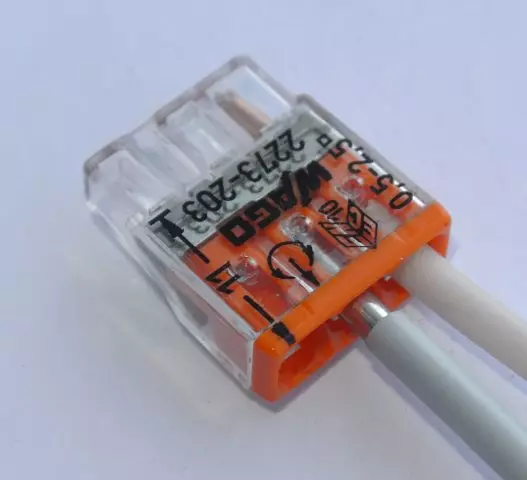
Spring terminals
The design of spring terminals was developed by the German company Wago. The principle of their work is that the conductors are clamped not with a screw, as in conventional terminal blocks, and a lever-type mechanism that is fixed by the veins without deforming them.
The case of the WAGO terminals is made of polymeric materials. The contact part is two brass plates, one is fixed rigidly, and the second is movable. The bare end of the wire is enough to insert into the cell of the terminal and lower the locking flag.
Article on the topic: Turquoise wallpapers: photo in the interior, for walls color, with brown pattern, room, white turquoise with flowers, curtains in bedroom, beige, video
There are two types of WAGO spring pads:
- Detachable.
- Digging.
The detachable terminals suggest a reusable use of the connection can be disassembled and gather again. Undoubted terminals are used only once. To repair wiring, the terminal box will have to cut, and after troubleshooting, install a new one.
Benefits of spring terminals:
- Quick installation.
- The connection of more than two conductors.
- Reliable contact without deformation lived.
- Hole for measuring network parameters.
- You can connect conductors from different materials.
Disadvantages:
- High cost compared to conventional pads.
- It is not recommended to use in networks with a large load.
Important. When connecting aluminum wires, it is recommended to pre-fill the terminal with contact paste to prevent oxidation. In the range of products of WAGO, there are terminals already treated with such a means of manufacture.
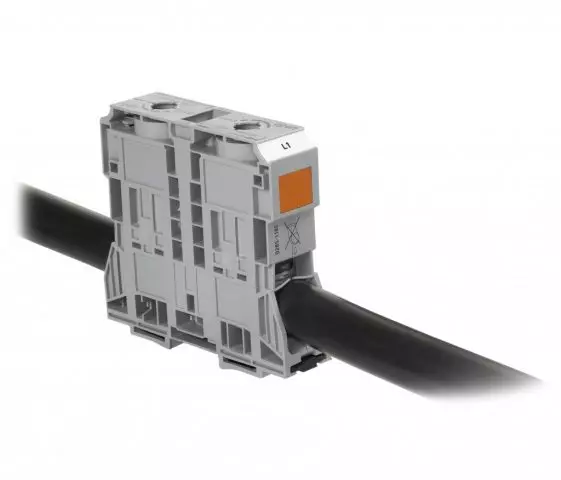
Caps Sizes
The design of connecting insulating clamps (PPE) consists of a cap and a cone spring inserted inside it. The cap is made of heat-resistant plastic withstanding voltage up to 660 V.
The connection of wires with caps of PPE is produced in two ways - with a pre-twin conducted and without. When connecting two conductors, it is enough to attach their bare ends to each other, put on a cap and rotational movements clockwise to make a twist. Coupling with a cap of three and more wires make, twisting their ends with passats. The insulation from the cables is removed so that the bare part does not protrude beyond the cap, the applying isolation does not need.
Advantages of caps SIZ:
- Low cost connectors.
- Quick installation.
- PPCs are made of non-combustible material.
- The caps have a variety of coloring, which makes it possible to label wiring.
Disadvantages:
- You can not connect copper conductors with aluminum.
- Relatively weak fixation and insulation.
To ensure that the connection is reliable, it is important to choose the desired clamp type. All CAP caps are labeled in which the type of housing is first indicated: 1 - no protrusion, 2 - with a protrusion for a more convenient capture of the cap with fingers. After the type of housing, the minimum and maximum total cross-section of the veins can be connected in the clamp.
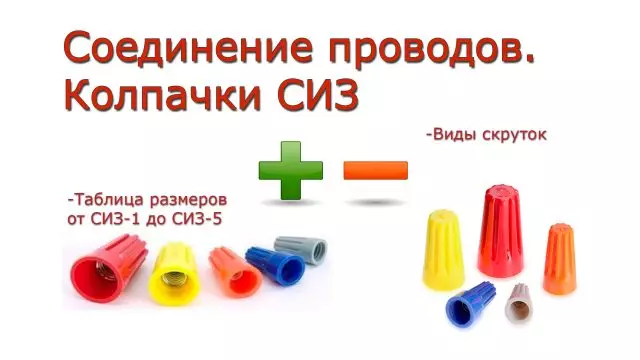
Pressing sleeves
The most reliable connection used in high current load lines. A tube is used as a clamp, into which the bare ends of the conductors will be created and crimped with mechanical or hydraulic press clamps. Some wizards for this purpose use passatasi, but in this case it is impossible to ensure the reliability of the connection.
The material of the sleeve must coincide with the material of the conductors. If you need to combine the copper cable with aluminum, use a combined copper-aluminum sleeve. The diameter of the tube is selected, depending on the total cross section of the conductors - after the ends of the ends, it should not remain emptiness.
Connection of wires with crimping is done so that their ends are approximately in the middle of the sleeve. The connection is insulated with a shrink tube or ordinary tape.
Advantages of crimping sleeves:
- Low cost of sleeves.
- Reliable connection with high mechanical strength.
- You can connect copper with aluminum.
Disadvantages:
- Local connection - if necessary, the sleeve will have to cut.
- For work, you need a special tool.
- It takes more time to carry out work.
Article on the topic: How to breed fish in a pond at the cottage, what fish is better to breed?
Important. Copper and aluminum are subject to oxidation. Before crimping, it is recommended to clean the wires to the brilliance and handle with a special lubrication.
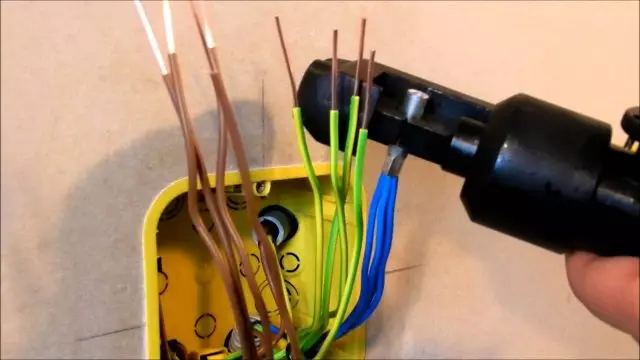
Soldering and welding
Soldering is old, but a reliable method used so far. Its essence is to connect the wires of the molten solder, which is pushing into the cleaners of the twist. After it is frozen, a monolithic connection is formed. The soldering is used for docking copper wires. There are fluxes and aluminum for sale, but experts prefer to refrain from its soldering. Soldering process:
- Remove from the ends of the wire isolation and clean it from varnish.
- Make a twist.
- Process the twist rosin.
- Heat the place of connection with a soldering iron with a scored solder until it fills all the gaps.
- Give cool.
- Treat the place soldering with alcohol and exhibit.
This method is well suited for docking conductors of small diameters. The resulting connection does not need to maintain the entire service life.
Benefits of soldering:
- Excellent connection quality.
- Low cost of work.
Disadvantages:
- Labor consumption.
- We need experience working with a soldering iron.
- Low connected connection.
- Cannot be used in high current loads.
To connect the welding cables, a welding machine is used. As in the previous case, the ends of the conductors are pre-twisted, then the coal or graphite electrode spill the end of the twist before the formation of the ball. As a result, a monolithic connection is obtained, distinguished by reliability. The disadvantages of this method are an inconsecting connection and the need to have a certain skill of working with welding.
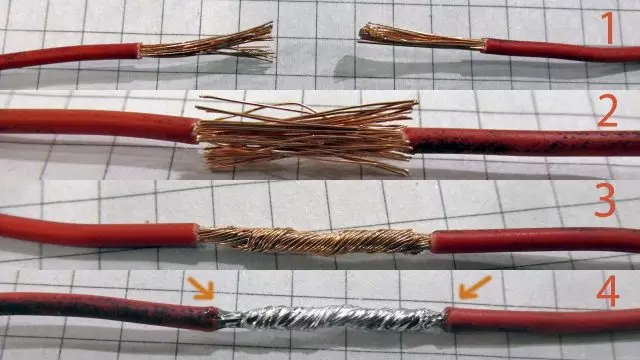
Twist and insulation
The essence lies in twisting the bare ends of the conductors among themselves with subsequent insulation. Even until recently, when the load in the apartments was only from lighting and television, the twist was used everywhere. Now it is forbidden to PEU, especially in wooden buildings and rooms with high humidity.
Advantages of twist:
- Easy work.
- No material costs are required.
Disadvantages:
- Low connection quality.
- You can not connect copper with aluminum.
Preparatory stage to soldering or welding, when installing temporary wiring.
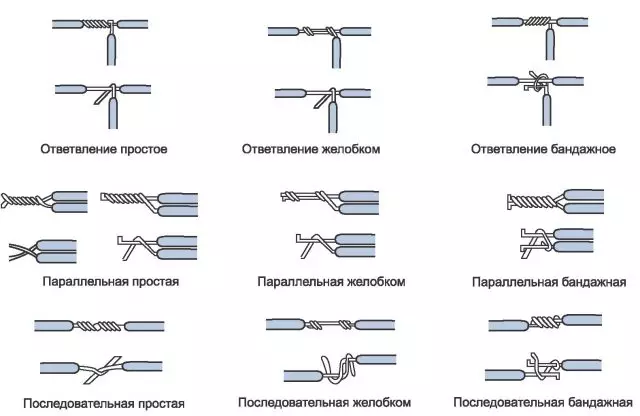
Connection of wires by the "Walnut" clamps
The branch slice is designed to perform branches from the main cable without its rupture. The clamping device consists of a collapsible polycarbonate housing, inside the steel core of two dies and an intermediate plate. Halves of the housing are interconnected by locking rings, and the dies are tied bolts.
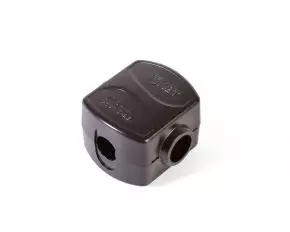
Installation of a branch compressory:
- Disassemble a branch spot.
- Remove isolation from the main wire for the waiter length.
- Turn the end of the exhaust wire on the wave length.
- Put the wires in the grooves on the dies.
- Tighten the core bolts, pre-laying a brass plate between the ds.
- Collect hull.
Important. It is necessary to correctly select the "Out" sizes, depending on the section of the cables used. The selences are selected in accordance with the range of sections indicated on the core plates.
Article on the topic: How to put a mosaic: stack on the wall, put and glued, paper base and video
Advantages of the "Walnut" compression:
- Low cost.
- Easy installation.
- The possibility of compounding aluminum and copper.
- Good insulation.
Disadvantages:
- Large dimensions of the device.
- It is necessary to periodically tighten the bolts.
The device is allowed to use in networks with a voltage up to 660 V. Walnut housing has quite good insulation, but it is not capable of providing full protection against moisture and dust. When compressing in adverse conditions, the housing is recommended to wrap the tape.
Bolt connection
All that will need to work is any bolt, the washers of the corresponding diameter and nut.
The ends of the conductors are cleaned by isolation. In the bare areas form loops on the diameter of the bolt. To simplify the work, the ends of the cables can be wrapped around the bolt and then spin. The connection elements are put on the bolt in the following order:
- Washer.
- Conductor.
- Washer.
- Conductor.
- Washer.
- Nut.
The nut is tightened by hands, then the key or passage. The finished connection is carefully isolated.
Advantages of the bolted connection:
- Easy work.
- Reliable contact.
- Low cost.
- Collapsible connection.
- Use in high-load networks.
Disadvantages: the bulkness of the structure, which can not always be fit into the junction box, high consumption isol.
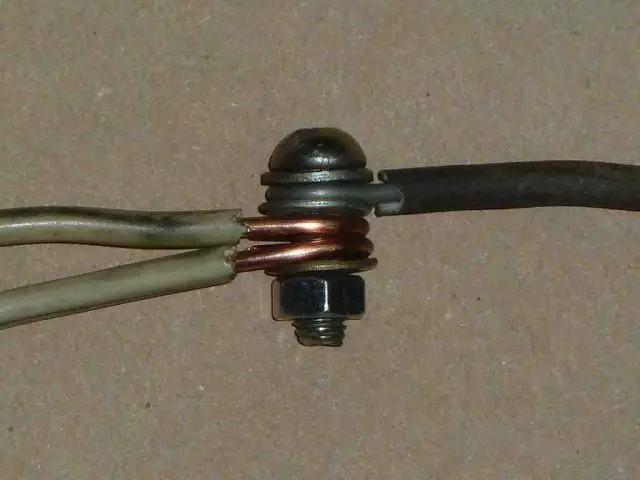
How to connect several wires
The following methods will be suitable for combining wires:- Spring terminals.
- A twist with soldering, welding or using caps of PP.
- Pressing sleeves.
- Bolted connection.
The first option is less labor-intensive and the fastest. A bolted compound is also suitable - the number of conductors is limited only to the bolt length, but the compound has large dimensions.
Connection of wires of different sections
When connecting the conductors of different sections, the twist cannot provide reliable contact, so all the methods associated with it are excluded. It is recommended to use terminal blocks, spring terminals or a bolt connection.
Combining stranded and single-core conductors
Does not have any features. Any of the described methods is suitable, the exception is only a twist of conductors from different materials. Otherwise, the choice depends on the preferences and financial capabilities. When using screw terminal blocks, it is necessary for the presence of tips on a stranded wire.Cable connection in water and underground
Electricity and moisture are incompatible things, therefore, for compounds made under water or in the ground, special requirements are presented. The ends of the conductors are combined by soldering or crimping sleeves. Then processed with thermal and isolate the heat shrink tube. If everything is done correctly, the penetration of moisture into place is excluded.
You can also use docking terminal pads. The connection site is placed in a hermetic box and fill with silicone sealant. The cable passing under the ground must be placed in a pipe or box of damage to rodents.
You can use one way or several immediately - it all depends on the installation. The main thing is that one should not forget - this is safety. The plot on which electrical installation works is made, it is necessary to disable from the network, to adhere to the PEU and use a good tool.
